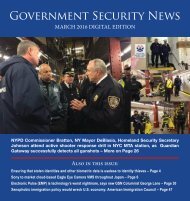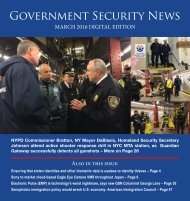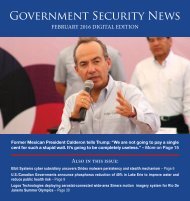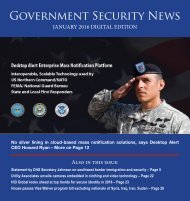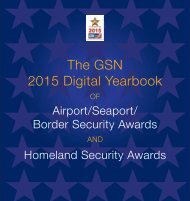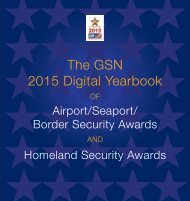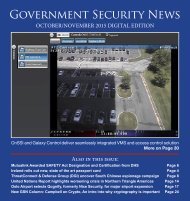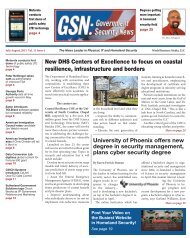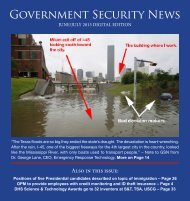GSN March 2016 Digital Edition
Create successful ePaper yourself
Turn your PDF publications into a flip-book with our unique Google optimized e-Paper software.
the workplace for any suspicious or<br />
unusual attitude among people in the<br />
workplace. Indications of disgruntled<br />
employees, unfamiliar people asking<br />
questions about security, access, workflow,<br />
or occupancy of gathering areas<br />
on the campus should be reported<br />
through a “tip line” or another process<br />
to support a “see something, say something”<br />
program.<br />
Provide Training<br />
Responding to an active shooter in<br />
the workplace is a supremely terrifying<br />
experience. This level of fear and<br />
anxiety can be reduced through multiple<br />
training sessions and “no-notice”<br />
exercises that reinforce the expected<br />
<br />
likely to reach a high level of trust and<br />
confidence with realistic training and<br />
an on-going reward system.<br />
The first level of training is creating<br />
awareness and providing didactic information<br />
to the attendees. Training<br />
should be factual, and based on reality.<br />
It needs to be more than just a plan or<br />
series of exercises – it needs to foster<br />
and support a strong survival mindset.<br />
The second level of training is to<br />
develop some “muscle memory” by<br />
actually walking through the process<br />
of running, hiding, and fighting. Try<br />
these three scenarios in multiple areas<br />
of the workplace so that these options<br />
are viable in your mind.<br />
The likelihood of being involved in<br />
a workplace shooting is infinitesimally<br />
small. These are low probability, high<br />
consequence incidents. Successfully<br />
interdicting and surviving one of these<br />
improbable events takes training,<br />
practice, and preparedness exercises<br />
conducted with real-world conditions.<br />
gency<br />
managers, and trainers should<br />
be vocal advocates and champions in<br />
making the workplace more resilient.<br />
Active Shooter Protocols<br />
For business leaders, staying informed<br />
of industry best practices for workplace<br />
security is paramount for maintaining<br />
an atmosphere of vigilance as<br />
well as a safe and secure environment<br />
for your employees.<br />
While it is true that your chances of<br />
being killed in an automobile-related<br />
incident are far higher than being<br />
killed at work or in a public place by<br />
a deranged shooter, being prepared is<br />
still the best option. In a world where<br />
these tragedies do sometimes happen,<br />
having a plan and procedure for how<br />
your organization will respond in a<br />
threat scenario is an important contributor<br />
to employee morale and productivity<br />
on a daily basis.<br />
With this in mind, here is a simple<br />
plan for training your workforce to respond<br />
to an active shooter threat.<br />
Alerts and Warning<br />
22<br />
Constructing the alert messages to<br />
go out to everyone on site should be<br />
viewed as an essential part of the preparedness<br />
effort. These messages must<br />
attract immediate attention, and move<br />
people to comply with the directive<br />
being transmitted. The specific verbiage<br />
relating to the source of the alert<br />
and the action words that describe the<br />
immediate options available should be<br />
clearly communicated.<br />
The mode and medium of communications<br />
should be chosen carefully<br />
to include text messages, email, voice<br />
announcements, desktop alerts, and<br />
other push notification apps. It must<br />
be decided if it would be advantageous<br />
to activate strobe lights, fire alarm<br />
enunciators, and speakerphones, or<br />
consider whether silent alerts would<br />
be a better option to allow people to be<br />
quiet and less noticeable when hiding<br />
from to perpetrators.<br />
It might make sense in one building<br />
to make loud noises to distract a<br />
potential attacker while in another<br />
building keep all messages silent after<br />
the initial alert. This has to be evaluated<br />
and worked out for each discrete<br />
environment.<br />
The planning and development of<br />
a series of alerts, warning messages,<br />
and status updates should be done by<br />
architects who possess training and<br />
experience in designing and communicating<br />
critical messages. The choice<br />
of words and subtle nuances must be<br />
carefully crafted to elicit the desired<br />
response from both employees and<br />
visitors, including those who may not<br />
More on page 27




